The rules for traveling to Mexico from the U.S. with a dog changed in 2019. If you’re planning to head south of the border with your pup, these tips will help make your trip a success!
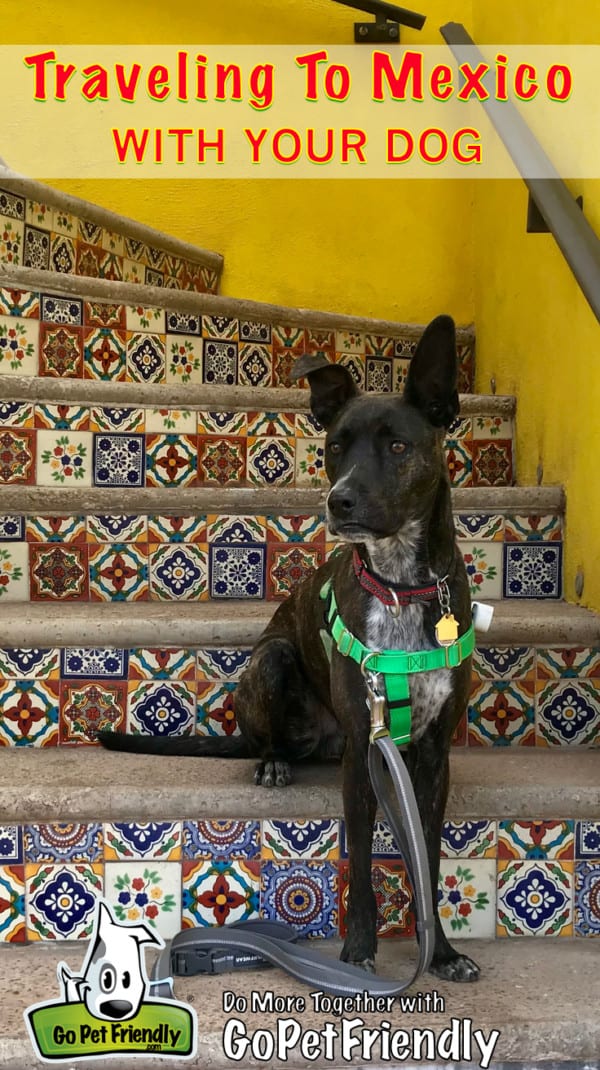
Whether you’re walking across the border for the day or planning a longer trip to Mexico, there’s no reason to leave your pup behind! The rules for traveling to Mexico with a dog changed in 2019, and it’s now easier than ever to take your furry travel buddy along.
But remember, it’s just as important to get back into the United States as it is to get into Mexico! So be sure you’re prepared for crossing the border in both directions.
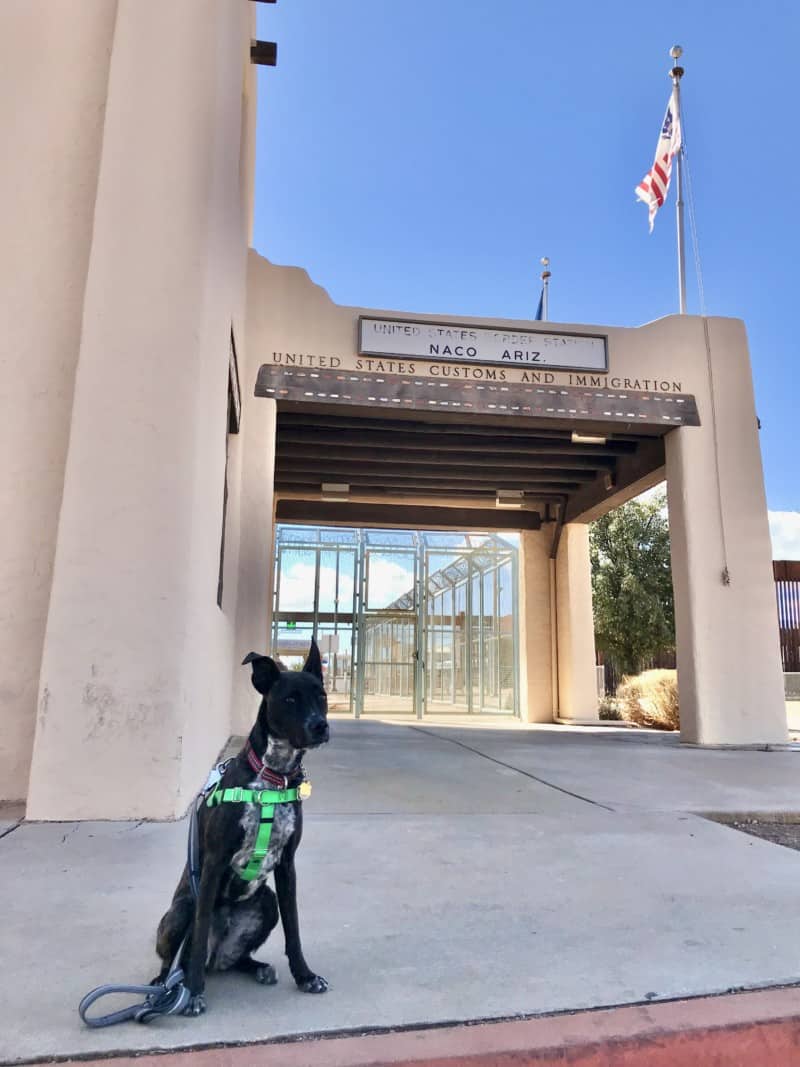
Traveling To Mexico With A Dog
Your experience crossing the border will be very different depending on how and where you travel. More scrutiny and inspections are common at busy crossing like San Diego and El Paso. If you’re flying in, your documents will also be reviewed more thoroughly.
In contrast, if you’re walking across the border, the process could be very casual – especially if you’re visiting a small town. Driving across the border will likely be somewhere in between, with where you choose to cross having the biggest impact.
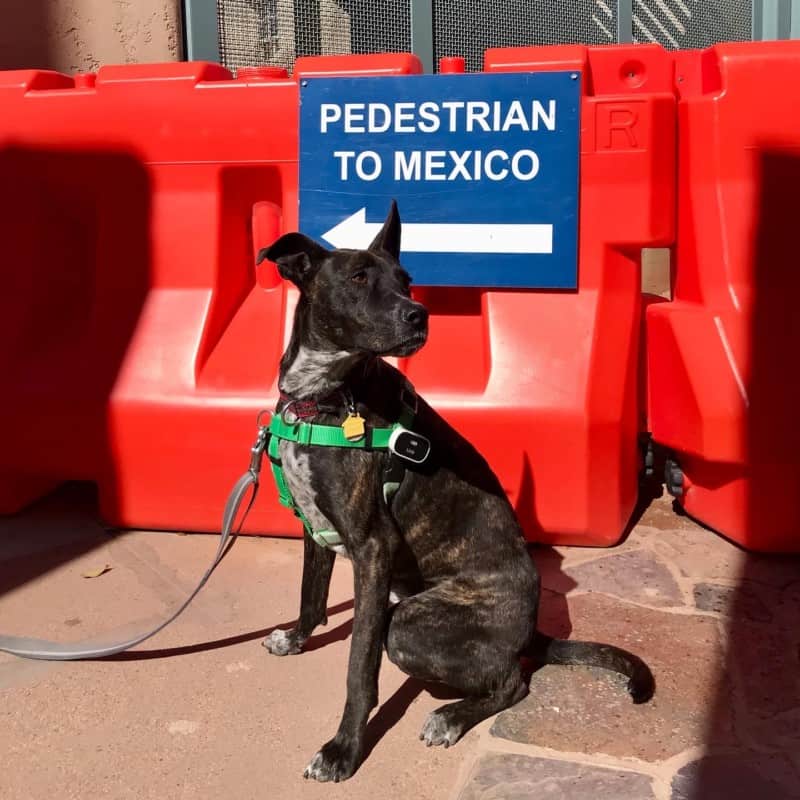
What People Need
Mexico requires all foreign citizens visiting the country to fill out an Official Entry Immigration Form, also called a tourist card, prior to their arrival. Tourist cards are free and you can fill out and print the form at home.
When you arrive at the border, present the immigration officer with your printed tourist card and your passport. Since your information will already be in their system, once your tourist card is stamped, you’ll be off to enjoy Mexico!
If you are walking across the border into Mexico, you might find the immigration officer doesn’t request your tourist card. Still, it’s better to have it prepared – just in case.
Auto Insurance
If you are driving in Mexico, you will also need to purchase Mexican car insurance. Even if your U.S. auto insurance policy covers you in Mexico, it cannot pay damages that you would legally owe to others if you were in an accident. Mexican law is very clear—in order to drive in Mexico, you must at least have Mexican liability coverage, underwritten by a Mexican carrier.

What Dogs Need
On December 16, 2019, the United States Department of Agriculture announced that cats and dogs traveling to Mexico from the U.S. no longer need a health certificate.
The rules now state that travelers with the pet dogs and/or cats must visit the Mexican Animal and Plant Health Inspection Office (OISA), and see the person working with SENASICA upon arriving in Mexico.
If you travel regularly between the U.S. and Mexico with your dog, you can request to register in the “Pet Program – Frequent Traveler.” For further information, refer to the USDA website.
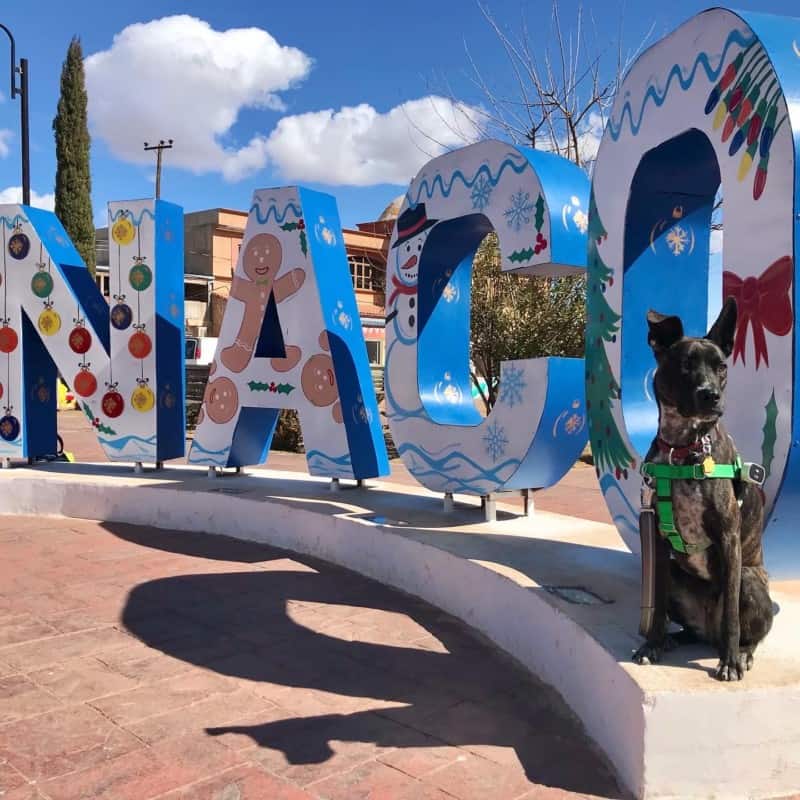
Pet Inspections When Entering Mexico
SENASICA inspectors aren’t present at every crossing. When we walked into Mexico from Naco, Arizona near Bisbee, there was no pet inspection. Myles simply strolled across the border with us.
READ MORE ⇒ Travel Guide: Pet Friendly Bisbee, Arizona
If there is a SENASICA inspector at your crossing, the rules state that pets must be presented clean cages or carriers. Though, we’ve heard this rules is not always enforced – especially for larger pets. If you cannot easily carry your pet in a carrier, presenting your dog on leash should be fine.
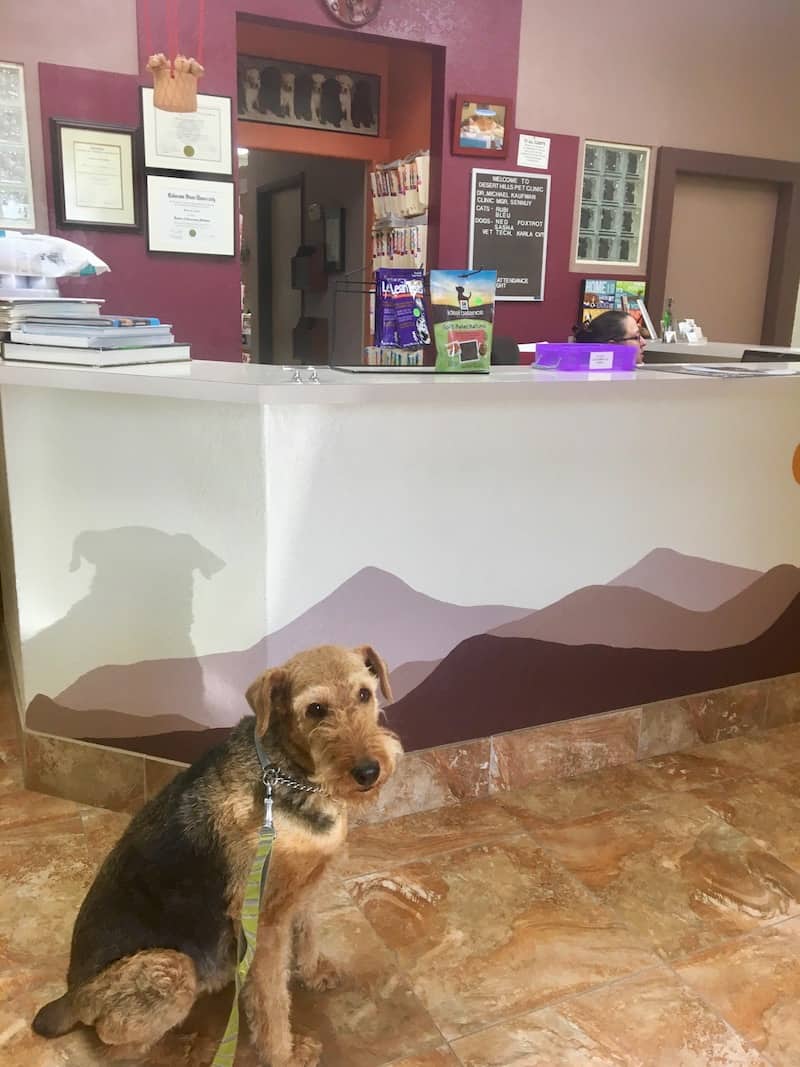
The SENASICA agent will perform a physical inspection of your pet to determine the following:
- Your pet shows no sign of infectious and contagious diseases,
- is free of ectoparasites (ticks), and
- has no fresh wounds or wounds in the process of healing.
If ticks are detected, your pet cannot cross the border. You’ll either need to return to the U.S., or the SENASICA agent will send a sample of the tick for diagnostic testing at the official laboratory. Your pet would have to remain at the OISA (Mexican official office) until confirmation is received that the parasites are not exotic/foreign to Mexico.
What If Your Pet Has Health Issues?
If your pet is being treated for lesions and/or infections due to a skin condition, present the SENASICA agent with the diagnosis and treatment instructions from your veterinarian. This information should be presented on letterhead, including the veterinarian’s professional registration number (or equivalent).
Can You Bring Pet Food Into Mexico?
When traveling to Mexico with a dog, the rules state you can only bring enough food to feed your pet that day. If you’re staying longer than a day, you could purchase pet food in Mexico. Or, consider shipping your dog’s food to your destination so it’s there when you arrive. Otherwise, you might be sharing your meals!

Something To Consider Before Traveling To Mexico With a Dog
In Mexico, we’ve found people to be very friendly toward Myles. Shopkeepers are generally less fussy about letting animals in stores, so traveling with a dog is pretty easy.
However, in Mexico and other Latin countries, you will often see dogs running loose in the streets. Generally, these dogs keep their distance. But if you have a reactive dog, this can be a stressful experience.
READ MORE ⇒ Tips For Traveling With A Reactive Dog
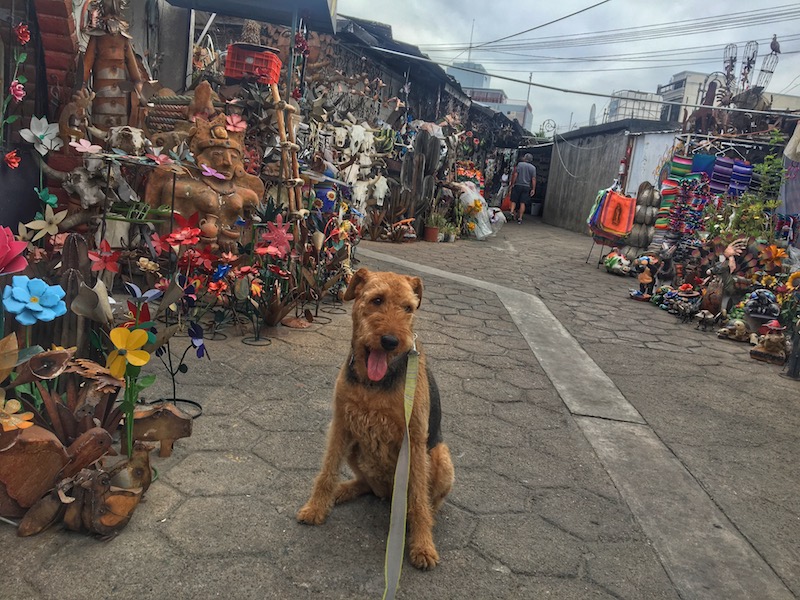
Returning To The United States
When you return to the United States from Mexico, U.S. citizens need to show a valid passport. If you are traveling by foot or car, you can provide a U.S. Passport card. This is a less expensive alternative to a full passport. But it only works for land and sea travel from Mexico, Canada, Bermuda, and the Caribbean.
Your dog needs less documentation to return to the U.S. than you! The CDC does not include Mexico among the list of countries considered high-risk for rabies.
So proof of vaccination is not required for dogs coming to the U.S. from Mexico, as long as your dog has not traveled to a high-risk country in the past six months. You’ll just need to provide a written or verbal statement your dog has only been in a country NOT at high risk for rabies for at least 6 months or since birth for puppies less than 6 months of age. And there is no limit to the number of dogs you can bring, as long as they are your personal pets.
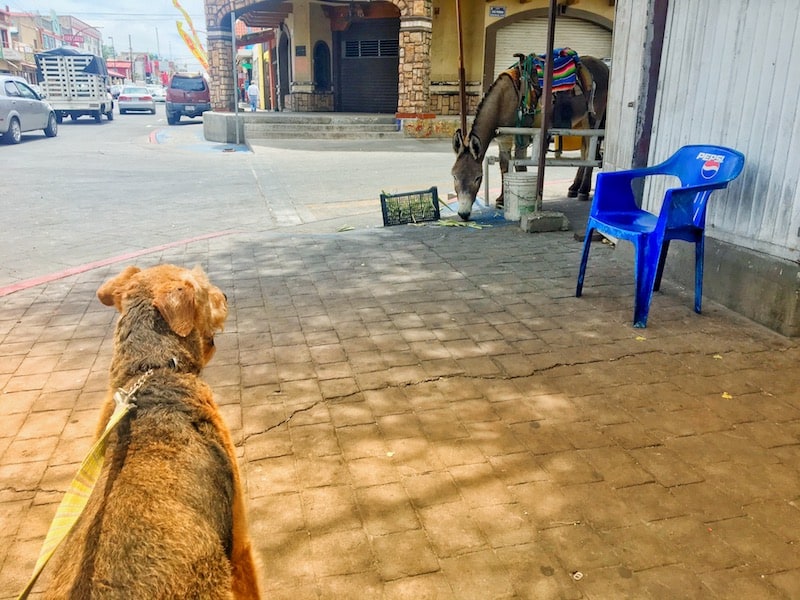
Have you taken your dog to Mexico? How was your experience?
Amazon Affiliate Disclosure: GoPetFriendly.com LLC is a participant in the Amazon Services LLC Associates Program, an affiliate advertising program designed to provide a means for website owners to earn advertising fees by advertising and linking to amazon.com, audible.com, and any other website that may be affiliated with Amazon Service LLC Associates Program. As an Amazon Associate, the owner of this site earns a commission from qualifying purchases.
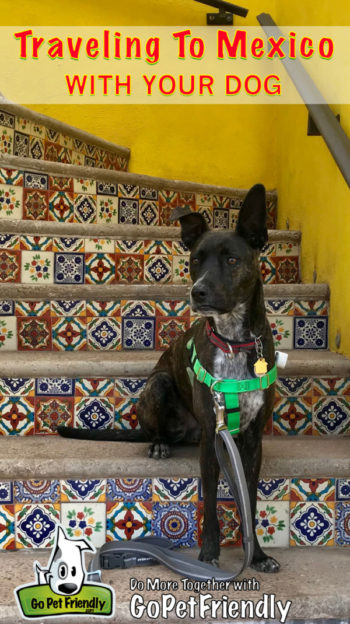
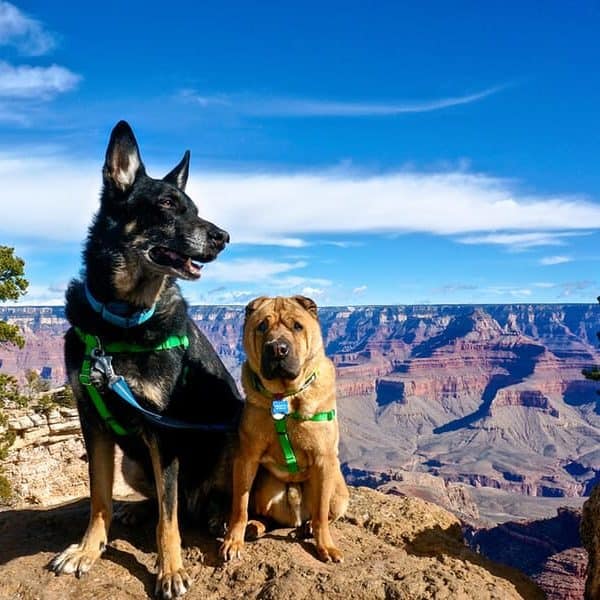

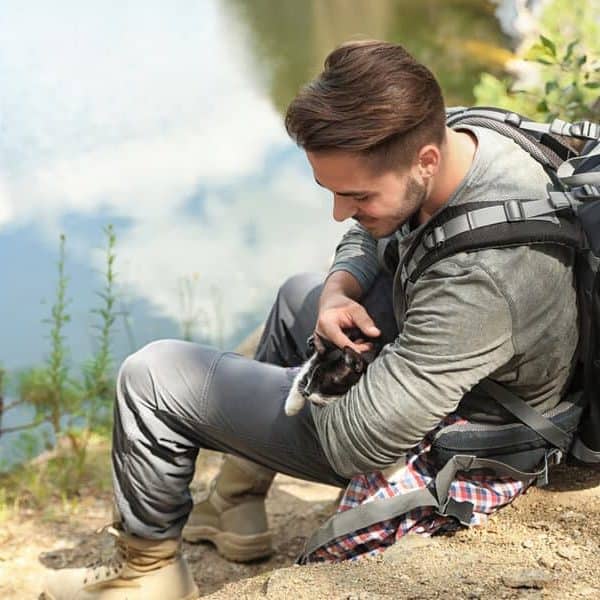

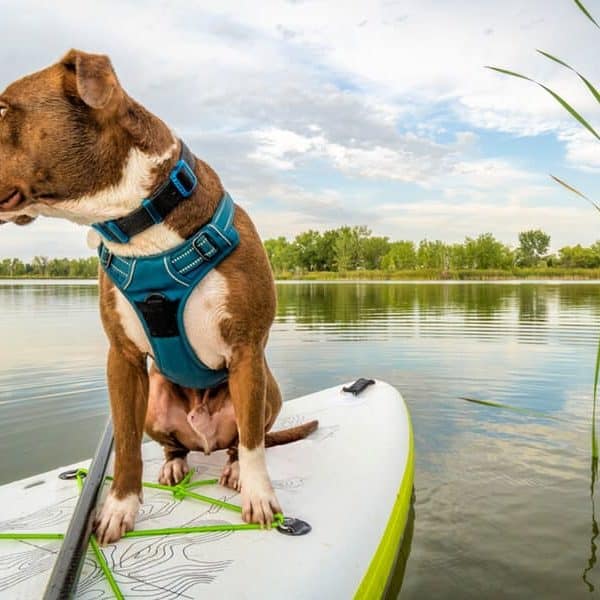





We just returned from spending an afternoon in Agua Prieta, MX with our dog. We walked across from Douglas, AZ near Bisbee where the infamous Myles & Maynard of Go Pet Friendly fame live. Thought I would share our experience. Crossing in to MX and returning back to the US was a piece of cake! No one asked a single question about the dog. Surprising. The only thing they did was ask me to do was remove his pillow from the pillow case as we crossed in to MX. He’s almost 19 yrs old so we travel with a giant wagon/stroller and there is a human pillow in the bottom. We knew a health certificate was no longer needed due to law changes a few years ago. We had his vaccination records with us just in case, but no one asked. We carried in extra water for him as we didn’t want him (or us) drinking the local water of course. Since we were only there for a few hours we didn’t take any food. My research I believe indicated you are only allowed to bring 1 days worth of food with you even if crossing for a longer period of time? The only “issue” we had was finding a pet friendly location to eat other than the numerous food trucks found in the Central Plaza district. There are tables & chairs in the plaza if you want to eat at one of the food trucks, but we wanted a local restaurant with some personality. We ended up at Mia Burrito (corner of Av 11 & Calle 7). Local burrito stand with a few seats at the outside bar (with shade) & a bathroom in their back kitchen if you ask nicely. Human bathrooms were nearly impossible to come by….fyi. We each had a burrito & a soda. Total was $9. The dog enjoyed tortillas. We had wanted to eat at Bizio Cafe. However, they were closed due to construction. They too have outdoor seating with shade and are pet friendly. As we were walking back towards the border entry we stumbled upon what would have been exactly what we were looking for restaurant wise. La Rueda is the name and it’s on the same street before you get in line to re-enter. Outdoor shaded seating. Street dogs in A P were almost non existent. Different than other parts of MX we’d been to. We encountered 2 street dogs and both just ignored our dog. We walked the streets before & after lunch and then easily crossed back in to the US. Again, no questions asked. The hardest part of the return was getting his huge wagon thru the 2 turnstiles at customs. Where to park? You can park at the Douglas visitor center, but that’s a bit more of a walk. Put Douglas, AZ Walmart in your GPS. Park in that vicinity. There is a large parking lot across from Walmart with an abandon store front. That was were someone suggested we park. However, we ended up parking a few blocks closer to the port of entry near Dollar Tree. There was a strip mall where the store fronts were not yet finished. There were other cars parked here that appeared to have been from people walking across as well. A quick/short walk to border entry. Was there much to see/do? Nope. Exactly as we had expected. It was something we did more for the experience. Eat a good meal. Support the economy. Get our exercise walking for the day. Make some more memories with our Chuckie The Travelin’ Adventure Dog! Hope this helps anyone else considering crossing with their dog.
How wonderful! Thank you for sharing your experience, Cheri. I’m so glad to hear that crossing to AP is so easy. We’ve been across the border to Naco with Myles, but we haven’t gone to Agua Prieta yet. It sounds like we’ll have to give it a try!
I am planning a trip to Mexico next year. My dog is 60 pounds would I have to put her with luggage?? That’s scary if so. Advice anyone?
Hi Kimberly! Thanks for your note. As far as I know, there are no airlines that allow a 60-pound dog in the cabin. So your pup would have to travel in the cargo hold if you fly. I’m not sure how far you’re traveling, but driving is the only other alternative that I’m aware of. For your reference, the airline pet policies are all provided in this blog post >> https://www.gopetfriendly.com/blog/airline-pet-policies/
Good luck!
Try flying JSX. Will cost more and you may need to drive to a city with a non stop flight, but your dog can buy the seat next to you.
I’m flying with my dog as carry on. Taking two different airlines. Both airlines United and American require heath certificate and vaccination certificate to Mexico and returning to California. The carrier that goes under the seat for United is 17” long, 11” wide. 10.5”high for soft carrier. American Airlines lines is 18” long, 11”wide, 11”high. Different size requirements for hard carrier. Both airlines charge a Fee of $125.00. United allows the pet carrier and one personal carrier on bag. AA said the pet carrier is the only carry on allowed. I bought one of the cross bags that that I can keep my personal items in. My dog carrier converts to a backpack and standard carrier.
Hi Lori! Thanks so much for sharing your experience. I hope you have a fantastic trip – safe travels!
Hi thanks for sharing your experinec. Could you please share you carrier ? I have a medium size dog 22-25 lbs
Hi T! I don’t know if you’ll hear back from Lori, so I wanted to share this post we wrote recently about crash-tested dog carriers. Hopefully it helps and you have a great trip! >> https://www.gopetfriendly.com/blog/crash-tested-crates-and-carriers/
I need to state that my travel is exclusively at international airports, not border crossings. For the poster coming from Texas. Save yourself the anxiety…we have travelled internationally to Mexico, Nicaragua, Belize, Honduras. Get your vet to compose a letter stating your pet is in health and free from parasites. Then pack a dose of the meds you use, complete with packaging and keep it near your paperwork as proof. I have actually had the vets office compose a letter after they administered the meds, signed by vet…yes 3 originals The Mexican inspectors could ask you to dose your pet on inspection.I ALWAYS have a minimum of 3 originals, signed by vet, in BLUE ink, as they might want to retain 1-2 copies. Make sure your rabies vaccine is up to date…they now accept the three year vaccination. It must be administered at least 30 days PRIOR to your trip if you are nearing end of your rabies coverage. Once again 3 original copies signed by your vet. See where we are going. I keep a record of all my recent visits, just in case. Put paperwork in a designated folder. If you overdo it, you can’t go wrong, but never have a been questioned in all my trips. Sorry, don’t know about crates. Good luck, after this trip you will be a pro!
I’m driving from Texas into Mexico in October 2022 and will be staying 6 months. There is so much conflicting info out on the web.about what I have to have to cross the border. Can you confirm that I don’t need to pay for a vet’s health certificate. Do i need to bring their medical records with proof of vaccinations? Is rabies the only required vaccination? Do you have to show proof of deworming? Do they have to be in a pet carrier when they cross the border? Any information you could provide or confirm would be greatly appreciated. Thanks.
You need a valid rabies certificate with your dogs microchip in order to return to the US . This is very strict and more research should have been done before writing this article.
Hi Cindy. Your statement would be true only if the dog had traveled to a “high-risk country for dog rabies” in the past 6 months. Mexico is NOT on the list of high-risk countries provided by the CDC.
Per the CDC website: “Dogs that have NOT been in a high-risk country in the past 6 months are NOT required by CDC to present a rabies vaccination certificate. However, when you enter the United States, you must provide a written or verbal statement your dogs have NOT been in a country that is high risk for rabies within the last 6 months or since birth if under 6 months of age. While CDC doesn’t require proof of rabies vaccination, CDC recommends that all dogs be vaccinated against rabies, and your US destination may have additional requirements.”
Here’s the link if you’d like to research it yourself >> https://www.cdc.gov/importation/bringing-an-animal-into-the-united-states/dogs.html
I hope that helps clarify things!
Cindy, your statement is incorrect. I have also researched this topic myself and found it to be accurate based on the USDA and CDC website. The requirement for proof of vaccinations and health certificates has been suspended since 2019.
Thanks, Jack! It’s always good to have someone double-check.
You do NOT need a microchip. I have had 3 trips with my service dog and I’m in Mexico at present. You DO need a valid rabies certification( 3 originals per visit…they retain one copy at inspection). I have my vet sign a letter stating dog is in good health without sign of flea or ticks( 3 original copies). My trips are less than 30 days. Perhaps pet travel is different than service dog travel. Never have I had to prove he has a chip.
When you return to US do you need letter from Mexican veterinarian stating dog is in good health without sign of flea or ticks plus has not travelled to high rabies country? What do you actually need to return back to US. Thank you.
Hi Maria! Thanks for your note. As long as your pet appears healthy, you don’t need any documentation to cross the border from Mexico to the U.S.:
“Proof of vaccination is not required for dogs coming to the U.S. from Mexico, as long as your dog has not traveled to a high-risk country in the past six months. You’ll just need to provide a written or verbal statement your dog has only been in a country NOT at high risk for rabies for at least 6 months or since birth for puppies less than 6 months of age.
I hope that helps and wish you safe travels!
That’s pretty informative, didn’t know that they carefully examine dogs when entering the border, there were probably a lot of precedents for that to be enacted. How does one just stroll/walk towards the border?
Hi Terrier Hub! I think the level of scrutiny depends on the location of the crossing. We’ve parked on the US side of the border and walked across a couple of times and no one examined our dog, Myles, at all.
I have 2 cats & 2 dogs- is that a problem to cross the border?
Hi Anabel! Thanks for your note. Unfortunately, the regulations for crossing into Mexico are a bit murky. There is one source that says only two pets can cross with you for free and there is a charge for additional pets. But in other places there is no mention of a limit on the number of pets allowed to cross with no fees. My feeling is that you’ll be fine crossing with your two dogs and two cats, and I’d love if you’d send a note and let us know how the crossing goes!
Help! I have a small (22 lb) dog who will not fit as carry on. None of the airlines seem to be transporting pets as cargo. I need to get from Baltimore-Washington area to Cancun with my dog. Anyone have any ideas?
Hi Scott! My suggestion is to reach out to the folks at PetRelocation.com. They help people move with their pets all over the world and should be able to help you find a solution. Wishing you the best of luck!
I love traveling with my dog to Mexico “Avi Kerendian” he enjoys it a lot!
That’s wonderful! Thanks for sharing, Avi. And waggin’ trails to you.
Hello. I’ll be flying JetBlue from New York to Cancun and then back from Cancun to Newark New Jersey. I know Mexico doesn’t require a health certificate but I am worried about coming back to US (New Jersey). I called the New Jersey department of health of agriculture and they said a health certificate and rabies certificate is required. My only question is, does the health certificate have to be endorsed by the USDA/APHIS (this process takes weeks and there’s extra work and fees involved). I know LEAVING the U.S, this is required to enter some countries. I don’t know how it works with coming back….
Hi Sunny! My guess is that a health certificate from a veterinarian is all that’s required. But that’s only a guess. To be absolutely sure it would be best to call the New Jersey Department of Health and Agriculture again and verify their requirements. Good luck and safe travels!
We will be going to Puerto Penasco with our 2 dogs for a long weekend. I am very concerned about not being able to bring enough dog food as the closest store to where we are staying is 30+ minutes and we have small children to trek there as well. Are they very strict about the food allotment?
Hi Stacy! From what I’ve been able to gather from people who have crossed the border with pets and reported back, the level of scrutiny really depends on the location that you cross the border. The big, popular crossing are more strict, and the smaller, quieter crossings generally garner less attention. I’m sorry I can’t give you a more definitive answer. I hope your trip goes well. And please come back and let me know so I can pass the information along to others!
I’m Mexican and use to travel with my dog. Mexico is the worst! Even if I’m enroll in the Pet Travel Mexican Program ( SENASICA ) is like Passport but the authorities are not familiar with their own program. Always carry Health Certificate even if is nor required. Food even if you are allow for the day if you get with a non informed authorities the take it away. You can not ship any kind of food if is not approve for the authorities. Better be inform what you can get in Mexico and try to feed your pet with the same in your place.
Be very careful where you dog sniff. Dogs get poisson in parks often. Leash always and id. Have handy a list of veterinarians in the area.
Thank you so much for sharing your experience, Azul! You’re the first person I’ve heard report these types of challenges. I hope the authorities become more familiar with their program and that crossing the border is easier for you in the future. Safe travels!
Condo rented in Mexico and pre paid, would not give us our room key with the service dog. Terrible experience.
They didn’t care about certificates, SD vest, etc.
I’m so sorry you had this experience, Toni! I do know that the Americans With Disabilities Act, which covers service dogs, only applies in the United States. Though other countries have similar laws, their requirements are different than here in the States. It poses an additional challenge when traveling abroad with a service animal, and I appreciate you for sharing your experience and highlighting the issue for others in the same position.
Hi! Do you know if there is a limit to how many dogs can travel with you in a car? Also, did you have to have a crate for your dog when traveling by car?
Hi J! We’ve seen conflicting information about the number of pets. Most of what we’ve seen says there are no limits, but one resource said two pets. Also, though they say crates are required, the people who’ve crossed the border and shared their experience have said crates weren’t required.
I’d like to be more definitive, but the information from the Mexican authorities is somewhat incomplete. I hope it’s helpful to you and that you have a safe and fun trip!
thank you, this was very helpful ! I’m wanting to fly with my small dog to los cobos, mexico. So I should just be prepared for them to do an inspection of her, close by the airport? I have all her records and shots.
Hi Dede! Thanks for your note. These guidelines are for people driving across the border to Mexico. Since you’ll be flying, I’d recommend checking with the airline to find out their requirements. They’ll likely request more documentation that if you were driving. Good luck, and safe travels!
How was the airport inspection? Have you gotten back yet? How was that process, if so?
How many dogs per person are you allowed to bring into Mexico? There will be two of us traveling with three small breed dogs
Hi Heriberto! In the most recent requirements provided by the Mexican government, there is no mention of a limit on the number of pets you can take across the border. You should be fine with your three dogs. Safe tavels!
We are in Mexico with our yorkies. We brought 2 bags of dehydrated raw. They seemed to care if it contained beef. The vet in Melaque sells dog food so you should be able to get yours in any bigger city.
Thanks so much for letting us know, Susanna! It’s good to hear from people who’ve been through the process. Safe travels to you!
I’m sorry, Grizz, but I don’t have the answer to your question. I suspect that the location of the OISA changes depending on where you cross the border. Safe travels to you!
I have flown into Mazatlan several times with my old puggle. The first two times a US Dept. of Agriculture certificate was required. I had to produce it in the luggage arrival area and was ushered over to a corner where the Mexican SENESECA or whatever they’re called inspector came around and physically inspected my poor dog. He really seemed to be looking for something wrong with my documentation. I flew in again about 5 months later with the same paperwork, but reissued and updated, and he found fault with exactly how my vet had entered the info about the parasite medications on the certificate. After a big deal about it, he said he would “let it go.” After inspection, they give you a two ply paper and collect the top half as you exit with your luggage and your dog. You keep the second half for when you depart, they ask for it at the airline check in. The third time, in February of 2020, I asked my vet for a USDA certificate again; I was told none was needed anymore but I asked for one anyway. All the websites and all the info I had said no certificate was required, but when I got to the inspection area, the inspector insisted on seeing a USDA certificate. I told him I thought I didn’t need one. He said no, I did. He seemed crestfallen when I produced one, then began to examine my dog. She is 13 and and has two grape-sized breast tumors on her belly. The vet said the only way to know if they are malignant is biopsy and surgery, but the dog is too old for that and surgical intervention is unlikely to help her at this time, so we are leaving them. Well, that inspector started squeezing and pulling at my poor dog’s tumors in a rather perverse way and I had to tell him to stop it. He issued his two ply certificate anyway and we proceeded without further perversion. We are planning on driving to Puerto Penasco with the dog soon, and I am going to travel with a USDA certificate, even though they are $65 at my vet’s. If my dog’s two tumors become an issue I am turning around and going back to the US.
Thank you so much for sharing your experience, Florence. I’m so sorry that your poor pup had to endure what sounds like an uncomfortable examination! If you would, please come back and let us know how things go when you drive across the border – hopefully everything is smooth and easy. Safe travels!
So here I am with an update–I drove into Puerto Penasco with my old puggle recently. I tried to get a USDA certificate from my vet but couldn’t get an appointment, ultimately I decided to just travel with the old certificate I had from 2020 and her vaccination records. We went in a pick up truck with a crew cab, and I bought a dog carrier sling that goes in the back and rests on the two jump seats. There was only one lane to go through in Sonoyta, and the Mexican official motioned us over for further inspection. My husband is Mexican, and was driving, and the official asked him what we had in the back of the truck (which was covered with a tonneau top). My husband said would you like me to open it up, and the official said yes. So my husband got out, opened up the back of the truck, the guy just took a quick look, and told us we could go. He never looked in the back of the cab and he never saw the dog, nor did he ask for my tourist card. So then we were on our way, and I didn’t even see the SENESICA office or any other place where I would check my dog in. My husband was very much, “let’s go, let’s not make any trouble for ourselves” so we just drove on and didn’t stop anywhere. Returning to the US, the Customs and Border patrol saw the dog in the back but didn’t ask for papers which was a good thing, because I seem to have lost the dog’s papers while at the Puerto Penasco rented beach house!
I really appreciate you for coming back to share your experience, Florence. Thank you! And I’m glad to hear your trip went smoothly. Waggin’ trails to you all!
I’m going to be traveling to Puerto Penasco in my truck with my two large doodles (1 is 65lbs and the other is 90lbs). I saw something on the USDA website about all animals needing to be in a crate when crossing the border. Is this the case? It would be very difficult to find one that will fit both dogs in the backseat of my Tacoma. Please let me know any info regarding this. Thanks!
Hi Matty! Yes, I’ve seen some indications of crates being required on the website. But I’m hearing from people who’ve crossed the border that they didn’t have a crate and all was fine. I can’t say for certain, because each agent could feel differently about following the “letter of the law,” but I think if your dogs are well-behaved you’ll be fine. It also wouldn’t hurt to have them buckled into seat belt harnesses!
Okay thank you Amy! The seatbelt harness is a great idea just in case!
Hi! I will be flying into Cabo San Lucas in October with my dog. Will she be screened medically at the airport or will I need to take her to a vet seperately? Also, does she need the ectoparasite treatment prior to flying or is that no longer a requirement?
Hi Phyllis! Thanks for your note. Since they’ve changed the rules and then the pandemic hit, we haven’t had any reports of people’s experiences flying with their pets to Mexico. My advice is to call the airline – they might be able to answer your questions. Or check with PetRelocation.com. They help pets move with their families all over the world and might have more experience in flying to Mexico. I hope that helps and that you have a wonderful trip!
When is the pet examine done, at the border or do we schedule it for after we’ve arrived at out destination?
Hi John! My understanding is that it happens at the border when you cross. Though, depending on where you cross there might not be an exam at all. I’ve been hearing reports from people crossing the border that no exam was done. Hope that helps and that you have a great trip!
I just came back from Mexico thru Nogales border. Going into Mexico back in early December, there was no problem whatsoever. They did not even ask a single question about my dog. I had spent over $200 on vet bills to get all the shots he needed & the accompanying letter of his good health. On our return to the US, it was the same. No questions asked nor documents required by the inspecting border agent.
Thank you so much for sharing your experience, Mahmood! The new rules haven’t been in place very long, so hearing from people who’ve been across the border really helps. Safe travels to you!
Do you know if we need crates or carriers for our two dogs?
And do they provide visas at the border like they do when you travel by air? Or do we have to print them out beforehand? This is mine and my husband’s first time traveling to Mexico by car (and with pets), so we have no idea what to really expect.
Hi Kimiko! The rules say that pets must be in crates or carriers. However, I’ve been hearing from people who have crossed the border that they did not have them, and there was no problem. It may depend on where you’re driving across. Unfortunately, that’s the best information I have.
As for visas, my understanding is that you’re meant to complete the paperwork online and print it to take with you. Again, whether it is checked or not could depend on where you cross. I hope that’s helpful and that you have a great trip!
Thank you!
Hi KamikoK, I am going to be headed to Mexico from the US with my two pups in December. Did you find out about the crates? we dont have them and I would hate to buy them. But I am also terrified of not getting through. How was your experience? and where did you cross? we will be crossing from Laredo.
We crossed through Laredo also, and we did not have our dogs in crates. They didn’t even ask for any paperwork for our dogs. Very easy!
That’s great! Thanks so much for sharing your experience.
This makes me feel SO much better. Thank you!
We fly to Mexico frequently from California with our small ESA dog. All Mexican airlines have asked us for health certificates and we have always been stopped at customs in Mexico. 99% of the time we are delayed by either Mexican airline employees or Mexican custom officers. They check and re check and check again all of our paperwork. In fact on our most recent trip 11/2019 they asked for our paperwork six different times. I haven’t flown since the new law and am curious to see if the Mexican airline have updated their policies. I checked online and see that they still require health certificates.
Hi Adam! Thanks for sharing your experience. And yes, in almost all cases airlines require health certificates for pets that will be flying – even if they’re not leaving the United States. I don’t expect the airlines to relax their rules, but the documents required to drive or walk across the border are less. Safe travels to you!
I’d like to know more about the kennel/cage rule as well if anyone crosses in the next couple of days. We will be crossing in about a week and I would rather not buy a crate if it’s not necessary or enforced.
Unfortunately, the rules are so new (and not clearly written), so we’re still figuring things out too, Mikey. I wish I could be more helpful. Please let us know what you learn when you make the crossing!
I am in Mexico cureently, we crossed the border on Jan 7, which is after the rule change. we crossed at bridge #1? (the commerical bridge) in Eagle Pass TX/Piedras Negras. I crossed on foot with a bicycle and my dog. we did not have or need a carrier/crate. They also never had us do the inspection. I had his vac, de-worming, and flea and tick records. nothing was asked for. I asked the inspectors if they needed anything else for the dog and they said “no” and told the guy at the imss office I had a dog with me and he didn’t care. we have been in Mexico for a month and past through 4-5 police and army checkpoints and noone has cared about the dog or asked for any paperwork. this is just our experience and other crossings may be different but they didn’t care where we crossed.
Thank you so much for sharing your experience, Mikey! I hope you’re having a wonderful time on your trip. Waggin’ trails!
How many dogs can you bring to Mexico from USA. I’m asking because we have 5 healthy dogs and my husband and I plan to drive to Mexico City this year.
Hi Tanya! I can’t find any limit on the number of dogs that you can take across the border, as long as they are your personal pets. I know that when crossing between the US and Canada there is no limit. I hope that helps!
This is great, the changes — thank you so much for posting.
I wonder if Canada will be next in relaxing the pet entry rules.
Hope so anyway.
Agreed, AH – that would be fantastic!
We are Canadians who also have a condo in the northern Baja where we have spent our last 12 winters. We cross the border (Mex/US) at least twice a month by car going into San Diego and always take our dog. I do carry her rabies and vacines certificate with us when we cross, but have never been asked for any documentation whatsoever when traveling by car in either direction. I am asked for the rabies certificate when entering the states BY AIR with her, (not by car) and also when returning to Canada by the Canadian officials when FLYING home.
Thanks so much for your note, Judy! We’ve found much the same when traveling with our dogs between the US and Canada – our paperwork is rarely checked. It is interesting to note that this new rule makes it clear that it’s the responsibility of the person crossing into Mexico with a dog or cat to visit the OISA office for an inspection of their pet. And there is no word on what the penalty for not doing the inspection will be.